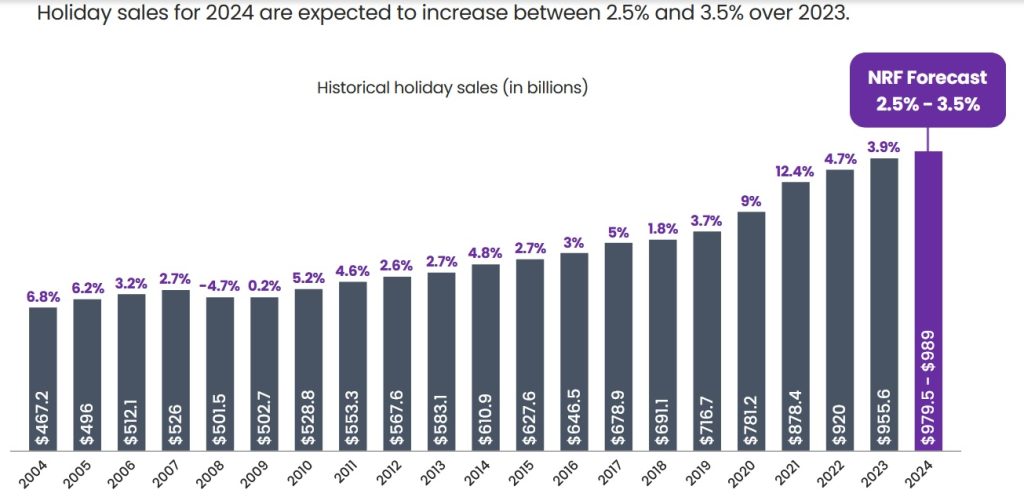The National Retail Federation,
The National Retail Federation forecast that winter holiday spending is expected to grow between 2.5% and 3.5% over 2023. That equates to between $979.5 billion and $989 billion in total holiday spending in November and December, compared with $955.6 billion during the same timeframe last year.
“The economy remains fundamentally healthy and continues to maintain its momentum heading into the final months of the year,” NRF President and CEO Matthew Shay said. “The winter holidays are an important tradition to American families, and their capacity to spend will continue to be supported by a strong job market and wage growth.”
The holiday forecast is consistent with NRF’s forecast that annual sales for 2024 will be between 2.5% and 3.5% over 2023.
A primary contributor of overall retail sales growth is expected from online shopping. Online and other non-store sales, which are included in the total, are expected to increase between 8% and 9% to a total of between $295.1 billion and $297.9 billion. This figure is up from $273.3 billion last year. By comparison, last year non-store sales rose 10.7% over 2022.
“We remain optimistic about the pace of economic activity and growth projected in the second half of the year,” NRF Chief Economist Jack Kleinhenz said. “Household finances are in good shape and an impetus for strong spending heading into the holiday season, though households will spend more cautiously.”
As retailers anticipate increased consumer demand during the holiday season, additional associates are needed to support business operations. NRF expects retailers will hire between 400,000 and 500,000 seasonal workers this year, some of which may have been pulled into October to support retailers’ holiday buying events this month. This compares with 509,000 seasonal hires last year.
One differentiating characteristic from last year’s holiday shopping season is that the shopping period between Thanksgiving and Christmas will be five days shorter, totaling 26 days. Additional contributing factors this year could include the economic impact of Hurricanes Helene and Milton; even though the 2024 U.S. presidential election will take place during the winter holiday season, it is nearly impossible to measure its impact on current or future spending.
NRF’s holiday forecast is based on economic modeling using various key economic indicators including consumer spending, disposable personal income, employment, wages, inflation and previous monthly retail sales releases. NRF’s calculation excludes automobile dealers, gasoline stations and restaurants to focus on core retail. NRF defines the holiday season as Nov. 1 through Dec. 31.
For more information, visit NRF’s Winter Holiday FAQ and Winter Holiday Headquarters.
As the leading authority and voice for the retail industry, NRF provides data on retail sales each month and also forecasts annual retail sales and spending for key periods such as the holiday season each year.
About NRF
The National Retail Federation passionately advocates for the people, brands, policies and ideas that help retail succeed. From its headquarters in Washington, D.C., NRF empowers the industry that powers the economy. Retail is the nation’s largest private-sector employer, contributing $5.3 trillion to annual GDP and supporting more than one in four U.S. jobs — 55 million working Americans. For over a century, NRF has been a voice for every retailer and every retail job, educating, inspiring and communicating the powerful impact retail has on local communities and global economies. nrf.com
Disclaimer: Articles featured on Oregon Report are the creation, responsibility and opinion of the authoring individual or organization which is featured at the top of every article.


